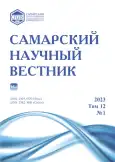The diatom analysis of the reservoirs located on the Kalmius River
- Authors: Mirnenko E.I.1
-
Affiliations:
- Donetsk State University
- Issue: Vol 12, No 1 (2023)
- Pages: 82-86
- Section: Biological Sciences
- URL: https://journals.rcsi.science/2309-4370/article/view/133947
- DOI: https://doi.org/10.55355/snv2023121112
- ID: 133947
Cite item
Full Text
Abstract
The paper examines biodiversity of diatoms in artificial reservoirs of the Kalmius river basin, as well as the degree of impact of industrial enterprises on water resources by bioindication. The author has established the current state of the water balance of rivers, and the use of water resources in the industry of Donbass. Thus, the water balance is formed due to a part of the inflow of water from the Seversky Donetsk river basin and the waters of the main Kalmius River basin. Agriculture and industrial enterprises in total consume 77% of the water resources of the entire region, which is an extremely high degree of involvement in the overall balance of water resources. To assess the condition of reservoirs, the method of determining the species diversity and biological analysis of diatoms DAIpo was chosen. As part of the study, it was found that the flora of diatoms according to the Shannon–Weaver index varied from 1,98 to 4,65 bps, while only 11 species of diatoms were massively distributed in reservoirs. The coefficient of growth of species diversity (r) varies (from 0,2135 to 0,9522 bps) depending on the season of the year and the place of selection. It was found that the increase in the DAIpo index occurred during the transition from the Nizhnekalmius reservoir to the Starobeshevsky reservoir, due to the presence of a larger number of saproxene species Achnanthes andicola, Fragilaria virescens, Navicula viridula var. viridula. Nitzschia sigmoidea var. sigmoidea, Navicula radiosa var. radiosa. Consequently, the paper traces the level of pollution by the presence of indicator species and the degree of tolerance of diatoms to environmental conditions.
Full Text
##article.viewOnOriginalSite##About the authors
Eduard Igorevich Mirnenko
Donetsk State University
Author for correspondence.
Email: eduard_mirnenko@list.ru
senior lecturer of Botany and Ecology Department
Russian Federation, DonetskReferences
- Баринова С.С., Медведева Л.А., Анисимова О.В. Биоразнообразие водорослей-индикаторов окружающей среды. Тель-Авив: Pilies Studio, 2006. 498 с.
- Авакян А.Б., Салтанкин В.П., Шарапов В.А. Водохранилища. М.: Мысль, 1987. 325 с.
- Горохова О.Г. Состав и структура сообществ фитопланктона реки Самары (бассейн Саратовского водохранилища) // Ученые записки Казанского университета. Серия: Естественные науки. 2020. Т. 162, № 3. С. 413–429. doi: 10.26907/2542-064x.2020.3.413-429.
- Бурдин Е.А. Волжская ирригация: миф или реальность? // Вестник Ульяновского государственного технического университета. 2012. № 1 (57). С. 58–60.
- Бунтовский С.Ю. История Донбасса: научно-популярное издание. Донецк: Донбасская Русь, 2016. 545 с.
- Государственный водный реестр [Электронный ресурс] // Государственный комитет водного и рыбного хозяйства Донецкой Народной Республики. https://gkvrhdnr.ru/gosudarstvennyj-vodnyj-reestr.
- Доклад о состоянии окружающей среды на территории Донецкой Народной Республики за 2021 год. Донецк, 2022. 89 с.
- Макрушин А.В. Биологический анализ качества вод / под ред. Г.Г. Винберга. Л., 1974. 60 с.
- Константинов А.С. Общая гидробиология: учеб. пособие. 4-е изд., перераб. M.: Высшая школа, 1986. 472 с.
- Мирненко Э.И. Оценка загрязнения органическими соединениями прудов г. Донецка // Проблемы экологии и охраны природы техногенного региона. 2017. № 3–4. С. 17–23.
- Мирненко Э.И., Касько А.А. Оценка состояния водохранилищ Донбасса по показателям степени сапробности // Проблемы экологии и охраны природы техногенного региона. 2020. № 1–2. С. 12–17.
- Suresh S., Aravinda H.B., Thirumala S. Phytoplankton for biomonitoring or organic pollution in two tanks of Davangere district, Karnataka, India // South Western Journal of Horticulture, Biology and Environment. 2011. Vol. 2, № 2. P. 107–112.
- Вассер С.П. Водоросли. Справочник / отв. ред. С.П. Вассер. Киев: Наук, думка, 1989. 608 с.
- Фомин Г.С. Вода. Контроль химической, бактериальной и радиационной безопасности по международным стандартам: энц. справочник. 3-е изд., перераб. и доп. М.: Протектор, 2000. 848 с.
- Asai K., Watanabe T. Statistic classification of epilithic diatom species into three ecological groups relating to organic water pollution. 2. Saprophilous and saproxenous taxa // Diatom. 1995. Vol. 10. P. 35–47. doi: 10.11464/diatom1985.10.0_35.
- Watanabe T., Asai K. Diatoms on the pH gradient from 1,0 to 12,5 // Proceedings оf the 14 International Diatom Symposium. Koenigstein: Koeltz Scientific Books, 1999. P. 383–412.
- Watanabe T., Asai K., Houki A. Numerical estimation to organic pollution of flowing water by using the epilithic diatom assemblage – diatom assemblage index (DAIpo) // The Science of the Total Environment. 1986. Vol. 55. P. 209–218. doi: 10.1016/0048-9697(86)90180-4.
- Watanabe T., Asai K., Houki A. Biological information closely related to the numerical index DAIpo (Diatom Assemblage Index to organic water pollution) // Diatom. 1988. Vol. 4. P. 49–60. doi: 10.11464/diatom1985.4.0_49.
Supplementary files










